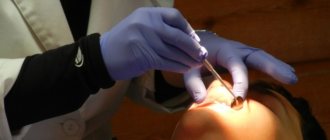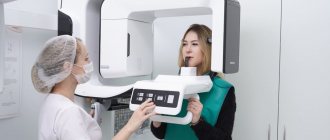If you notice such an unpleasant symptom as toothache, do not put off visiting the dentist. In cases where pain is accompanied by fever, it is better to immediately seek emergency dental care. Pain is an alarming signal from the body about the presence of a condition that threatens health. Accordingly, toothache and fever always signal a pathological condition. The normal body temperature is considered to be 36.6 ºC. If it is higher than these values, this indicates inflammation, which can be caused by viruses or bacteria. Fever and fever may indicate serious complications.
Toothache and fever
In this article we will figure out what to do if your tooth hurts and your temperature is elevated, as well as why this condition occurs.
Causes of increased body temperature - normal and pathological
Pain always signals that something in the body is not going as it should. Painful sensations along with elevated body temperature, when the mercury rises above 37 degrees, indicate that the body is reacting to external pathogens.
The body temperature rises in order to create an unfavorable environment for the development of infection. Also, with high numbers, interferon is better produced, which is necessary for the body to fight foreign organisms. For these reasons, you should not lower your temperature, except in cases where it is so high that it itself begins to threaten your health (above 39-40 degrees).
Elevated temperature is a protective reaction of the body
Important ! Antipyretic medications do not eliminate the source of the disease, but only relieve symptoms. This can be harmful because it will interfere with the fight against infection.
Only a doctor can determine the cause of the increase in temperature. For this purpose, tests and necessary examinations are prescribed. You can try to find out on your own why this or that painful condition develops, but doing this instead of visiting a specialist is strictly not recommended.
Causes of periodontitis
One of the causes of elevated body temperature may be periodontitis. This is a complex disease that occurs as a complication against the background of processes such as caries and pulpitis. In such cases, inflammation affects not only the tooth itself, but also nearby tissues. The development of this process is preceded by prolonged pain caused by bacterial damage to the tooth tissue.
Periodontitis is one of the causes of fever
Symptoms of periodontitis include fever and toothache. The pain is constant, acute, does not decrease when taking analgesics and intensifies with any load on the diseased tooth. In addition to these, the following symptoms are observed:
- swelling of the gums adjacent to the diseased tooth;
- swelling of the cheek on one side;
- enlarged and painful submandibular lymph nodes;
- sensation of changing the size of the diseased tooth.
Periodontitis therapy
As a rule, in case of periodontitis, it is recommended to remove a damaged tooth. The possibility of its preservation is considered in each case individually and depends on the nature of the damage and the severity of the disease. As a therapy for periodontitis, anti-inflammatory drugs with calcium hydroxide are used, which are placed in previously sanitized dental canals. This treatment takes a long time due to the fact that the drug acts slowly.
Important ! If the process is complicated by the presence of a cyst on the tooth, the apex of the root or the entire tooth is removed.
If the disease is severe, the tooth may be removed
Periostitis
If you start periodontitis and do not start treatment on time, an even more serious complication may arise - periostitis. In this case, the periosteum and jaw bones become inflamed. Abscesses form and purulent inflammation develops. Pus comes out of the abscess through the fistulous tract. Symptoms of periostitis are as follows:
- How long does it take for drugs to leave the body?
- acute toothache;
- temperature increase;
- facial tissues swell greatly on one side;
- weakness from intoxication;
- the pain radiates beyond the affected area - to the temples, ears, neck, eyes.
Periostitis most often occurs as a complication of periodontitis
Important ! If periostitis develops, the gums swell not only around the affected tooth, but also around nearby teeth.
Treatment methods for periostitis
Under no circumstances should you self-medicate and the patient should immediately go to an emergency dental care center. There they determine how the treatment will be carried out - surgically or conservatively.
Treatment is either surgical or conservative
With the surgical method, a purulent abscess on the gum is operated on and the contents are drained; In order to avoid the accumulation of pus, drainage is installed. The actions are carried out under local anesthesia.
Important ! If the tooth is too damaged and conservative treatment does not help, extraction is performed. If the condition of the tooth and adjacent tissues allows, the canals are cleaned and a filling is placed.
During the rehabilitation period, physiotherapy is prescribed and antibiotics are prescribed.
Alveolitis
In some cases, pain and fever begin immediately after tooth extraction. For the first two days, this is acceptable, especially in cases where the process was complex and it was necessary to operate on the gums or extract parts of the tooth. In such cases, the temperature may rise for up to a week, gradually decreasing. However, you need to remain under the supervision of a doctor until the symptom goes away completely.
High temperature occurs in cases where wound healing after dental extraction does not proceed as expected. Alveolitis occurs - inflammation of the tooth socket. Most often, this happens because the wound left after extraction becomes infected, and the blood clot, which normally protects the wound from external influences, is missing or damaged for some reason.
Alveolitis occurs due to infection entering the socket
As a rule, the clot is damaged if the dentist’s recommendations are not followed correctly (mechanical damage to the clot when eating or brushing teeth, vigorous rinsing of the mouth, etc.). Another reason is weakened immunity.
Important ! Also, the clot can be damaged due to erroneous actions of the doctor.
The following symptoms indicate alveolitis:
- increased pain after tooth extraction;
- increased body temperature (above 38-39 degrees);
- the appearance of plaque on the hole;
- unpleasant taste in the mouth, odor;
- swelling of soft tissues;
- enlarged submandibular lymph nodes;
- weakness and malaise.
With alveolitis, the temperature also rises
Treatment methods for alveolitis
This is a serious complication that requires long-term and complex therapy. The set of treatment measures is as follows:
- The dentist thoroughly sanitizes the hole, removing all foreign particles: food debris, tooth fragments, etc.
- The wound is washed with antiseptics, excess fluid is removed from it, and if necessary, antibacterial treatments are used.
- A bandage is applied to prevent pathogens from entering the wound.
- Physiotherapy is prescribed: laser, ultraviolet or microwave treatment, fluctuarization.
- The patient is advised to take antibiotics and antiseptics prescribed by the doctor.
Fluctuarization
Otitis media
Fever and toothache do not always occur only with pathologies associated with teeth. Sometimes they appear due to otitis media. The area of the tympanic cavity in the middle ear becomes inflamed. This happens due to various infections - for example, ARVI.
- Treatment of cystitis in women and men. How to properly treat cystitis?
Symptoms:
- the appearance of pain in the ears;
- hearing loss;
- painful sensations radiating to the jaw;
- heat.
Interesting ! Since pain from otitis media radiates into the jaw where the molars are located, it is often perceived as dental pain.
With otitis media, such problems can also be observed
Sore throat after dental treatment
It happens that after treatment, a patient not only has a toothache and fever, but also a sore throat. What are the reasons?
Firstly, a sore throat could be present before treatment and intensify after visiting the dentist, in a qualitative response of the body.
Secondly, it is rare, but it still happens that the doctor touches the mucous membrane of the throat with an instrument.
And finally, thirdly, pain after tooth extraction or treatment can radiate to the throat.
All of the above can cause a sore throat after visiting the doctor, but in rare cases, pain may occur several days after taking it.
Sinusitis
Another disease not related to teeth, but which gives characteristic pain and temperature is sinusitis. Caused by inflammation of the maxillary sinuses. They destroy the wall adjacent to the oral cavity, so the sensation is reminiscent of toothache.
Sinusitis causes similar symptoms
Sinusitis can result from the following diseases:
- ARVI;
- acute or chronic rhinitis;
- chronic tonsillitis (inflammation of the tonsils);
- damage to the teeth of the upper jaw by caries.
Important ! Patients with such anatomical features as narrowing of the nasal passages and deviated septum are at risk. Another cause of sinusitis is errors during surgical interventions on the upper jaw.
With sinusitis it is also difficult to breathe through the nose
One of the symptoms of sinusitis is an increase in temperature to 39 degrees. The disease is accompanied by severe pain in the forehead, nose, maxillary sinuses and cheekbones. It becomes difficult to breathe through the nose, and as the disease progresses, greenish discharge appears.
After implantation
Implantation is an operation to implant an artificial titanium root into the bone tissue of the jaw , on top of which, after regeneration is completed, an abutment and crown are fixed. Such treatment is always difficult and traumatic. It is performed under local anesthesia and requires long-term rehabilitation.
Meanwhile, it is implants that make it possible to restore the integrity of the dentition without damaging healthy units. Their installation is not associated with grinding down the “neighbors” or root canal treatment. Implantation is indicated if the tooth is completely destroyed, and even its roots are unsuitable for prosthetics.
Dentists always warn that after installing a titanium base, an elevated temperature may persist for three to five days, and this is normal. Fever indicates the active occurrence of regenerative processes. To avoid possible complications, the patient must take medications prescribed by the implantologist strictly according to schedule.
It is important to understand that the line between normality and pathology is very thin. Fever after implantation can also be a dangerous signal. So, sometimes it indicates rejection of an artificial structure. Then the person feels severe pain in the area of the surgical intervention, observes swollen gums from which pus is released, and constantly feels an unpleasant taste in the mouth. Soon the implant becomes mobile, which indicates its active rejection.
In this case, there is no point in hoping that the situation will normalize on its own. You need to go to the doctor immediately. The sooner the patient visits the doctor who implanted the implant, the higher the chances of stopping further progression of inflammation. If time is lost, the titanium base will most likely have to be removed.
To lower the temperature or not to lower it?
If the thermometer does not rise above 38 degrees, taking antipyretics is not required - this is the body’s protective reaction to the invasion of bacteria and viruses. To alleviate the condition, painkillers and anti-inflammatory drugs are prescribed. It makes sense to lower the temperature only in cases where it rises significantly above 38 degrees.
It's not always worth lowering the temperature
When to go to the doctor
It is important to monitor your condition after dental treatment. Toothache and fever may be normal. If after treatment a low temperature rises from the tooth in the evening, then it is better not to knock it down. When urgent matters arise, it is recommended to take antipyretic medications to feel better and cope with urgent tasks. In this case, it is useful to drink anti-inflammatory herbal tea with chamomile and rose hips. During this period, you should reduce your sugar intake, give up alcohol and smoking. Compliance with hygiene rules and following the dentist’s instructions will speed up the healing process of the wound.
After 1-2 days, such symptoms disappear completely. In this case, drowsiness and general weakness may occur. If the temperature persists for a longer time, then it is worth paying attention to whether the patient has symptoms of acute respiratory infections. Viruses can cause complications in a wound.
If the temperature lasts 2-3 days, but there are no symptoms of ARVI, then be sure to make an appointment. As a rule, these symptoms are accompanied by severe pain, swelling of the cheek or redness of the gums. If the fever is above 38 degrees, then you need to urgently go to the dental clinic. The permissible period of increase in body temperature after dental treatment does not exceed 4 days.
After the examination, the doctor will resort to additional diagnostics to find out the cause of the increase in temperature. The doctor may decide that special procedures will be needed to prevent the spread of infection.
What actions should you take if you experience toothache and fever?
The first step is to see a doctor. If the temperature rises strongly and suddenly, you should immediately call an ambulance.
Relief of condition
If the symptoms are so severe that they cause severe pain and interfere with normal sleep, you can try the following ways to relieve pain and alleviate the patient’s condition.
- Mouth rinse. To do this, you can use a variety of solutions: herbal mixtures, salt solution or special rinses, for example, Asepta Active. This product contains active ingredients such as chlorhexidine and benzydamine, which have an antimicrobial effect, as well as antiseptics and analgesics. This solution relieves pain well and helps restore damaged tissue.
"Acepta Active"
- Compresses with essential oils will be especially effective for periodontitis or inflammation of the dental pulp. A cotton swab is moistened with essential oil of fir, cloves or camphor and applied to the affected area for 20 minutes.
- Traditional medicine offers the following remedies for the treatment of fever and toothache: propolis (used in the form of tincture or lozenges), a mixture of onions, salt and garlic (crushed to a paste and applied to the affected area). Such compresses should not be kept for longer than 15-20 minutes.
- It is recommended to stay upright more to reduce blood flow to the upper body, in particular to the affected tissues. Mechanical effects on the affected area of the tooth, chewing and thermal effects are completely eliminated.
To soothe toothache, it is recommended to remain in an upright position.
- A good solution would be to try to distract yourself from painful sensations - spend time on something you love, do something that requires concentration, or simply clean up your home.
By following these recommendations, you can survive between visits to the doctor. However, no home remedy can replace qualified medical care.
Important ! Try to be more careful and do not forget to undergo preventive examinations.
After root canal treatment
Endodontic therapy involves complex manipulations. After it, your health may actually worsen. How long the painful condition will last depends on the degree of damage to the tissues of the oral cavity and the extent of the abnormal process.
Pulpitis itself rarely provokes fever, but its complications - periodontitis, cysts, periostitis, any purulent processes - quite often. Hyperthermia occurs in response to an inflammatory response. In parallel, the following may be observed:
- swollen lymph nodes;
- strong pain;
- swelling of the cheek;
- gum “bump”;
- discharge of purulent masses.
If after endodontic intervention the elevated temperature lasts longer than two to three days, you should definitely consult a doctor. This must be done immediately if the tooth hurts or pus flows.
First aid for fever and toothache
You should make an appointment with a doctor as soon as possible - any pre-medical care is aimed only at eliminating the symptoms, and only a dentist can perform the cause and correct diagnosis. The reasons can be very different - damage to dental tissue, inflammation of the gums, neuralgia and others.
- How to deal with unpleasant odors in the home of a seriously ill person
It is better to call an ambulance if the temperature rises above 39 degrees
It is especially critical to visit a doctor as quickly as possible if symptoms persist for longer than a day - the temperature may be due to the fact that the infection is in the blood, and this is fraught with serious complications. If weakness and poor health do not allow you to get to the dentist on your own, and the temperature rises above 39 degrees, it is better to call emergency help.
Toothache in children
If the described symptoms occur in a child, parents should start with an independent examination of the oral cavity - often a diseased tooth can be noticed on its own. If the pain is caused by a piece of food stuck in your teeth, you can carefully remove it yourself. The child’s diet is designed so that excessively cold or hot foods, as well as salty and spicy foods, are excluded. The mouth should be rinsed with herbal decoctions or a warm solution of baking soda.
Before going to the dentist, it is better for children to rinse their mouths with special solutions or decoctions.
As mentioned above, a visit to the doctor cannot be postponed. If for some reason it is not possible to immediately contact specialists, you can provide first aid yourself. Children's analgesics with ibuprofen and warm rinses will help.
Remember ! These are exclusively temporary measures and not a replacement for full treatment and diagnosis.
How to relieve toothache in children?
If pain occurs during teething, you can use auxiliary means - dental rings or cooling ointment. Teething rings can be purchased at the pharmacy. They are filled with a special gel, and it is better to cool them before use. Gels and ointments for gums can be purchased at the pharmacy. They should be prescribed by a doctor, taking into account the characteristics of the child’s body. You can give small pieces of carrots or apples to chew.
To relieve teething pain, it is recommended to purchase special rings
| Problem | Treatment |
| Pain caused by caries or pulpitis | This position will make it easier to rinse with a warm baking soda solution every 15 minutes. Decoctions of medicinal herbs such as chamomile, St. John's wort, mint, chicory and others can be used. |
| Another option is compresses with dental drops. This product can be purchased at a pharmacy; it is a liquid pain reliever consisting of infusions of valerian, camphor and mint oil. | |
| Gum inflammation | If there are no problems with allergic reactions, you can try a remedy such as clove essential oil. It is applied to a gauze pad and placed on the gum and/or aching tooth. |
| Another option is to massage the auricle on the side where pain is felt (this helps due to irritation of biologically active points). | |
| Pain after tooth extraction | Such pain can be relieved by rinsing with soda and mild children's painkillers. |
Important ! Pediatric anesthetics can also help, but they should be used carefully, in accordance with age standards.
It is best to prevent such problems from occurring and take your child to regular dental appointments. There are many children's clinics where examinations can be carried out easily and painlessly, with playful elements. It is very important to develop the right attitude towards treatment in a child and prevent fear of dental procedures at an early age.
To prevent dental disease, you should regularly visit the dentist with your child.
To prevent problems with teeth and oral cavity, it is necessary to follow a proper diet, eat foods rich in phosphorus, vitamins (especially vitamin D), and calcium from early childhood. The consumption of fast carbohydrates and sugars is limited. A good habit is to rinse your mouth after meals and brush your teeth regularly. For children, it is better to use children's toothpastes with a special composition containing substances to protect thin enamel.
Features of dental treatment in children
Since baby teeth are somewhat different in structure from permanent teeth (they have thinner enamel and dentine layers, a larger pulp chamber, enamel wears out faster, etc.), and also have a relatively short lifespan, dental treatment in children has a number of features. Since the enamel wears off quickly, the filling material is not too hard so that over time the filling does not destroy the walls of the teeth and does not protrude beyond the edges of the tooth, interfering with normal chewing. Typically, glass ionomer cements are used, which are not as hard as photopolymer composites. They contain fluoride ions and therefore have a strengthening effect on dental tissue.
In addition, you need to take into account that caries in children can develop very quickly and spread to other teeth - parents do not always have time to notice the beginning of the process in time, so they have to treat several teeth at once. At the same time, timely detection of the disease guarantees painless dental treatment for children without the use of a drill: if the infection has affected only the enamel, it is possible to carry out remineralization therapy or treat caries using Icon technology, which involves the use of a special composite material that reliably closes and seals the carious cavity. However, it must be taken into account that this technology is not recommended for use in children under 3 years of age and cannot be used for cervical caries.
In cases where the replacement of milk teeth with permanent ones is still far away, and the dental tissues are already thoroughly destroyed or the tooth needs to be removed, special children's prosthetics are used using crowns without grinding.
Some features of therapy for tooth pain and high fever
In order to avoid complications or tooth extraction, you should contact your dentist immediately after detecting symptoms.
- Frequent urination or why do I pee so often?
Important ! In cases where cysts are detected, treatment is carried out surgically (by removing the cyst) or conservatively (using debridement and cementation of the canals).
One method of treating a cyst is to use electric current on the diseased tooth. If extraction was not necessary during treatment, the tooth is filled. To exclude the occurrence of a cyst in the future, it is recommended to take preventive x-rays.
Treatment methods differ depending on the pathology
The following tips will help relieve toothache due to sinusitis.
- Removing mucus from the maxillary sinuses - it is necessary to relieve swelling of the mucous membranes with the help of vasoconstrictor drugs. They are used in the form of drops or tampons.
- In case of acute pain accompanied by purulent discharge, the paranasal sinuses are washed without piercing by creating a vacuum in the nasal cavity.
- In order to enhance the effect of other treatment methods, laser therapy is prescribed.
Treatment of pulpitis
As soon as the diagnosis of “pulpitis” is made, the dentist begins to treat it using one of the methods: preserving the entire pulp, with its partial or complete removal from the root canal system.
The method of preserving the entire pulp is currently not popular, since such treatment often causes a large number of complications. Of course, each case of pulpitis treatment is individual, but in most situations, dentists still choose the third treatment option - complete removal of the pulp.
In cases where, due to the structure of the canal, it is not possible to go through it completely, the doctor uses the method of partial removal of the pulp.
Stages of endodontic treatment
If a patient consults a dentist at the initial stage of pulpitis, treatment is considered simple and usually takes place in one visit. When pulpitis is advanced, long-term treatment in several stages is required.
Stage one
Introduction of anesthesia, isolation of teeth using a rubber dam - a special latex lining.
Stage two
Cleaning dental canals from bacteria, providing access to them through a prepared carious cavity, removing the roof of the pulp chamber and providing access for instruments to the canals.
Stage three
The canals are treated using mechanical and chemical methods. At this stage, it is very important to determine the true length of the canals, for which the doctor enters files into them and takes an x-ray.
The doctor carries out chemical disinfection using disposable dental needles. The use of pastes for pulp necrosis involves the use of special antiseptics or medications for additional disinfection of the canals. Depending on the chosen treatment tactics, the process can take from one to four days.
Stage four
After making sure that the canals are completely cleaned, the doctor proceeds to the final stage - filling. However, after filling the canals, the full treatment of pulpitis is not considered complete. To speed up the recovery process, an experienced dentist must prescribe procedures that will minimize post-filling discomfort and help avoid inflammation.
Prevention methods
The main preventive measure, as we mentioned earlier, is regular dental examinations. Even not the most serious symptoms are grounds for a visit. General recommendations include regular dental and oral hygiene and taking vitamin supplements high in calcium. This will help avoid toothache and inflammation.
It is important to maintain oral hygiene











